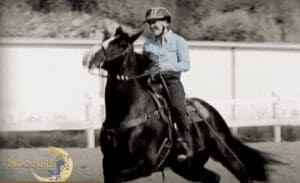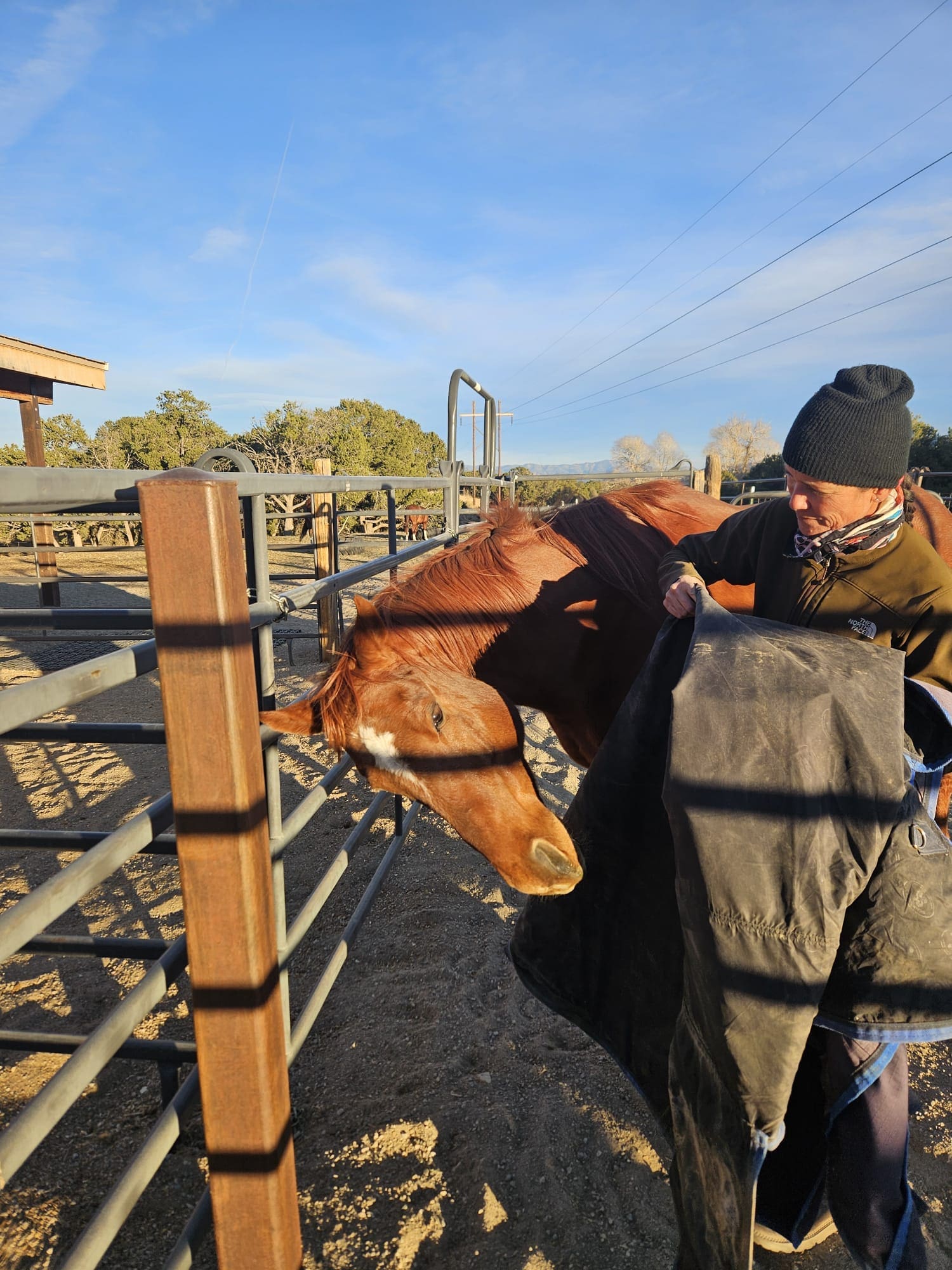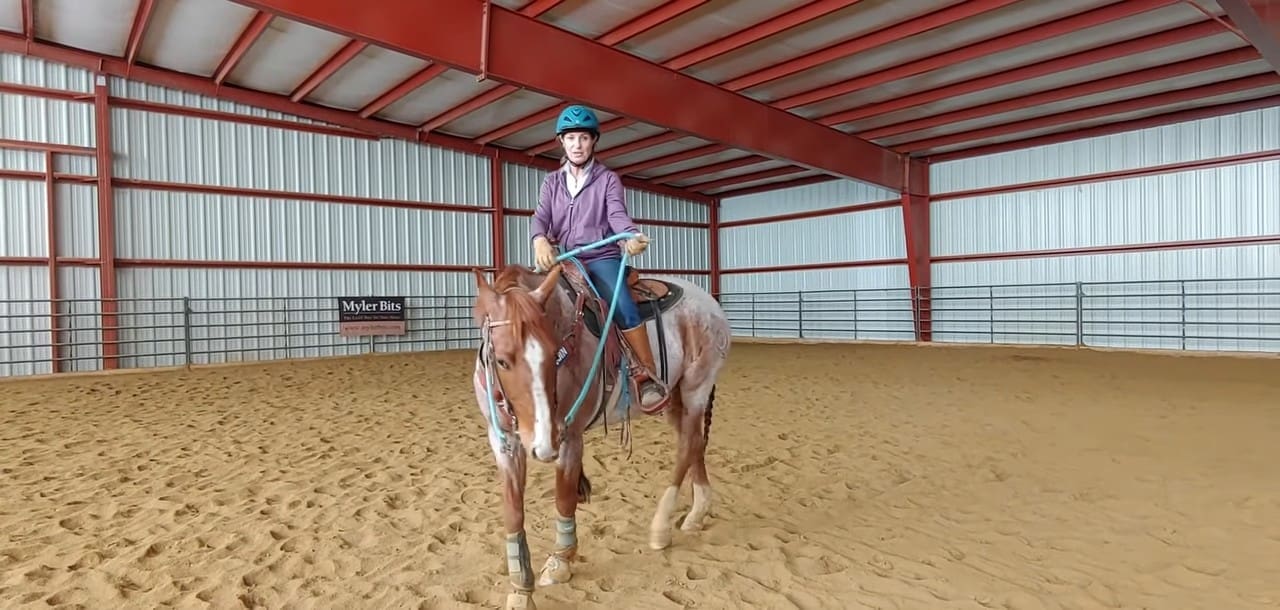
In the last month, most of the horse activity around my ranch has centered on the weather. January can be fickle up at 8,000 feet above sea level. We usually get some warm, sunny days in between snow storms, but this winter the snow, wind, and subzero temps have been steady. Our small herd of four horses spend their days out in the paddock and nights in the barn. (They like their creature comforts.)
Casper (Rich’s 10-year-old ranch gelding) and Tom (our new 4-year-old cutter) are blanketed every night, and most days, while Abner and Annie only don a cover when it’s single digits and below or snowing sideways. Tom was recently imported from Texas with a very slick hair coat, and Casper is in training, so we try to keep the hair short. The other two horses have full winter coats and can handle the cold temps just fine. After January, we will likely start seeing the weather improve with less bitter cold, but more snow. February, March and April are our snowiest months, and then it’ll be foaling season!!!
Annie’s pregnancy is progressing nicely, and she seems very content with her new life. Both Abner and Casper tend to sandwich her in protection, so she feels cozy and safe. I’m sure she would take pregnancy over being in-training any day, but all kidding aside, Annie has always been intensely attracted to foals in a very nurturing way, so I really think she is living her best life. Her due date is April 28th, give or take a few weeks. That day will be here before we know it, but we are ready!
When we brought our new horse, “Katz in a Kradle” home in mid-December, we decided “Tom” would be his barn name—as in tomcat, because he’s an own son of renowned cutting horse stallion, Highbrow Cat. He’s out of a Dual Rey daughter—royal breeding for sure!
After a long stint of intensive cutting training and competition before we got him, Tom was ready for some R&R. Mostly, we’ve been allowing him to recuperate, settle into his new home and new herd, and have some veterinary treatments to address the recent stress on his legs. Rich is easing him back into work now, and Tom is feeling his oats!
Integrating Tom into our small herd was easy, as I knew it would be. First of all, we only had three horses—all of whom get along well with others, and are skilled at staying out of the fray (more submissive). From our brief time with Tom, we believed him to be friendly, smart, and easy to get along with (and he is). To get him home from Fort Worth, TX, to Salida, CO, it was a two-day trip with a layover night in Amarillo.
When he arrived at our ranch, his new home, Tom had a lot of pent-up energy! Once we put him in his stall, next to the other horses, it was apparent that he needed to run off some steam. He’s a hotblooded horse and fit as a fiddle. After being confined in stalls and barns for some time without turnout, he needed to express his “yayas.” We had a lot of room to let him run, but I doled out his freedom a little bit at a time.
First, into a slightly bigger pen, until he settled…
And then into the long alleyway, for the most fun…
It took a while to get to the bottom of his full tank of rocket fuel!
I decided not to quarantine Tom on his arrival since by then he’d been with us—healthy and happy—for more than a week. (And because our quarantine pen had hay stored in it, which was currently buried under feet of snow.) Knowing all the horses and taking all the facts into consideration, I took a calculated risk on that, and it worked out just fine, thankfully.
We allowed Tom to get to know the other horses over the fence first, and there was little to no excitement or signs of aggression, as we anticipated. Abner and Casper thought he looked okay, but Annie was put out about a young whippersnapper disrupting her bliss. She bared her teeth, swished her tail, and charged the fence a few times, but Tom basically ignored her.
We turned Tom out with Casper first, and they got along fine—soon they would quickly become sparring-mates. Adding Abner to the equation was pretty much a non-event, but Annie didn’t want anything to do with Tom, in typical “you stink, I hate you, go away” fashion.

Goodnight's Principles of Riding Training Videos
Position, balance, rhythm & cueing
Exercises to improve riding skills
Cantering—everything from how to ride the canter to flying lead changes.
For the more advanced rider, advanced use of the aids, collection & lateral movements
I’ve known very few horses lower in the pecking order than Annie. Tom kept his distance from her for a few days, but soon enough he started ignoring her bluff. Then he walked straight up to her, and quietly and confidently kicked her off her hay pile. That was the end of Annie’s stink-eye. She by no means loves Tom, but she has fully accepted his presence in the herd.
Things will change again for Annie when she gets closer to foaling. She’ll want to stay more separated from the geldings because mares prefer to be off by themselves when they foal. One of the biggest risks to a newborn horse that’s born in a herd is the theft of the foal by another horse during the critical postpartum hours. This is when the foal is learning to stand, developing its gaits, finding its food source, and bonding with the mare. All of that occurs within a few hours, but early separation can be fatal to the newborn. Both jealous geldings and foal-less mares can be culprits in foal-theft, and it’s a serious concern.
Of course, we won’t let anything like that happen to Annie! As we get closer, we’ll be watching her like a hawk, and taking no chances. We’ve got cameras set up in every stall now, and it gives me great peace of mind to check in on my sweet little mare when I am away from the barn (as I am now).
We are eagerly awaiting Annie’s foal, and we are thrilled with our new horse, Tom. I hope to be riding him soon!




